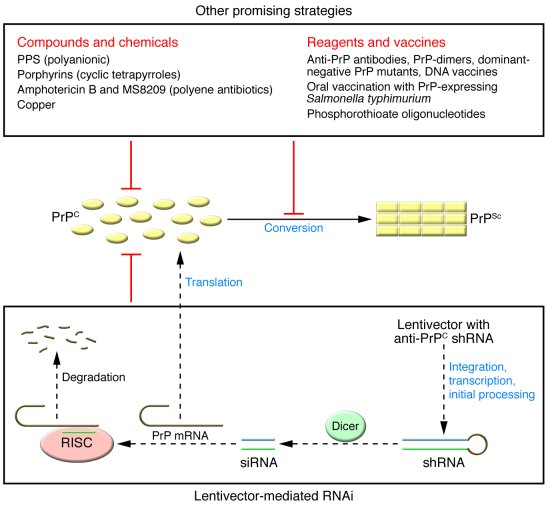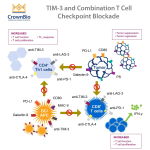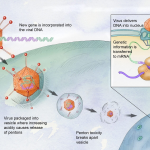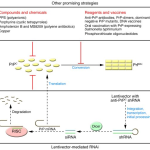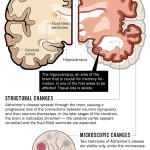As researchers race towards breakthroughs in prion disease treatment, the urgency is underscored by the devastating effects of such conditions. Prion diseases, including notorious variants like Creutzfeldt-Jakob disease and fatal familial insomnia, devastate brain function through misfolded prion proteins, leading to severe neurodegeneration. Recent pioneering studies have illuminated the potential of gene editing therapy to modify the genetic sequences responsible for these harmful proteins, presenting a beacon of hope for those affected. This innovative approach could revolutionize our understanding of gene therapy for prion diseases, offering a pathway towards effective interventions. With promising early results in laboratory models, the quest for a cure is not just scientific; it has become a deeply personal mission for many involved.
In the realm of neurodegenerative disorders, the search for solutions to prion diseases has garnered significant attention from the scientific community. These disorders, characterized by abnormal prion proteins leading to conditions such as variant Creutzfeldt-Jakob disease and familial insomnia linked to genetic mutations, present unique treatment challenges. Advances in genome editing technologies have opened new avenues for potential therapies, enabling researchers to target and edit specific genes responsible for these conditions. The intersection of groundbreaking gene therapy and personal stakes in prion disease research sheds light on the profound connection between scientists and their work, fueling an urgent desire for lasting solutions.
Understanding Prion Diseases
Prion diseases are a rare category of neurodegenerative disorders caused by misfolded prion proteins. These proteins can trigger abnormal folding of normal proteins in the brain, leading to progressive brain damage and devastating effects on cognitive functions. Among these diseases, Creutzfeldt-Jakob disease and fatal familial insomnia are the most recognized. While Creutzfeldt-Jakob disease usually occurs sporadically, fatal familial insomnia is hereditary, stemming from genetic mutations in the prion protein gene.
The mechanisms behind prion diseases are complex and not completely understood. Researchers believe that the misfolded prion proteins lead to neuronal apoptosis, resulting in severe dementia and other neurological symptoms. Approximately 15% of prion disease cases arise from inherited mutations, while the remaining 85% are sporadic, requiring ongoing research to unlock potential therapeutic pathways and interventions.
Progress Towards Prion Disease Treatment
Recent advances in gene editing therapy are paving the way for potential treatments for prion diseases that were once deemed untreatable. A groundbreaking research study led by David Liu at the Broad Institute has demonstrated that altering a single base in the gene responsible for producing prion proteins can significantly reduce the levels of these harmful proteins in laboratory mice. This astonishing result led to a 52% increase in lifespan for affected mice, offering hope to those at risk of inheriting conditions such as fatal familial insomnia.
However, while these initial results are encouraging, researchers caution that several challenges remain before any treatment can be confirmed for human use. The path to human trials involves months, if not years, of further testing and refinement of the gene therapy techniques used to ensure efficacy and safety. As researchers endeavor to perfect their methods, they remain hopeful that clinical applications will soon be in reach.
The Role of Patient-Scientists
The collaboration between scientists and patients provides a unique perspective and motivation in the pursuit of breakthroughs in medical research. For instance, Sonia Vallabh, a patient diagnosed with fatal familial insomnia, has transitioned from law to neuroscience to better understand the prion diseases that affect her and her family. This personal connection drives her and her husband, Eric Minikel, to make significant strides in the field of gene therapy for prion diseases, fostering innovative approaches that could lead to effective treatments.
Working directly alongside leading researchers in the field allows patient-scientists to contribute valuable insights on disease mechanisms and patient experiences, fostering a deeper understanding of the conditions being studied. In return, their involvement encourages researchers to push the boundaries of their work, knowing it has the potential to change lives, including that of their collaborators.
Gene Editing Therapy’s Breakthroughs
Gene editing therapy, particularly base editing, has emerged as a promising avenue for targeting prion diseases. Focused on precisely altering genetic sequences, this innovative technique allows scientists to create specific corrections within the genome, effectively addressing the roots of conditions such as Creutzfeldt-Jakob disease. The recent study highlighted the potential of gene editing to not only halt the progression of prion diseases but also to reverse some of their effects, as observed in the animal models used in their research.
This method’s precision is crucial for developing safe treatments for prion diseases, which pose substantial risks due to their infectious nature. As researchers continue to refine the gene editing techniques utilized, the hope remains that gene therapy could ultimately be adapted for use in human patients, providing a much-needed lifeline for individuals facing currently untreatable conditions.
Collaboration in Prion Disease Research
Collaboration among researchers differently positioned within the scientific community has led to tremendous advancements in prion disease research. The intertwined efforts of geneticists, neurologists, and researchers specializing in animal models have created a multidisciplinary approach that fosters innovation and enhances the understanding of these rare disorders. The cooperation between scientists, such as those at the Broad Institute and Harvard Medical School, showcases how shared knowledge can propel the field forward.
Such collaborations also provide a significant advantage during the experimental phase, as diverse expert perspectives allow for a comprehensive assessment of methods and potential implications of each study conducted. The involvement of various experts ensures that every aspect of the research is meticulously scrutinized and optimized, promoting effectively targeted solutions that could soon translate into successful therapies for prion diseases.
Challenges in Prion Disease Therapeutics
Despite the hopeful advancements in prion disease treatment, significant challenges must still be navigated. The inherent complexities of the neurodegenerative processes involved in diseases like Creutzfeldt-Jakob disease make it difficult to design effective, safe treatments. Researchers must conduct extensive preclinical studies to clarify the long-term implications of any gene-based therapies provided before they can safely transition to human clinical trials.
Another major challenge lies in the delivery mechanisms of gene therapy. Designing vector systems that efficiently and safely target the right cells while minimizing off-target effects is critical. While advances have been made in using adeno-associated viruses to serve as delivery vehicles for gene editing materials, researchers continue to optimize how these tools can be utilized for the best therapeutic outcomes.
The Future of Gene Therapy for Prion Diseases
Looking into the future, gene therapy for prion diseases presents a beacon of hope for the millions affected by these conditions. As research progresses, our understanding of the prion protein and its role in disease pathology will undoubtedly deepen, providing further insights into potential mechanisms for intervention. Ongoing studies are anticipated to clarify optimal gene editing strategies and improve therapeutic techniques that can ultimately be applied to human subjects.
While there are still many hurdles to overcome, the collaborative efforts and personal anecdotes from patient-scientists like Vallabh and Minikel are driving the mission forward. As more breakthroughs in biotechnology emerge, the prospect of tackling prion diseases through innovative therapies becomes increasingly feasible, potentially transforming the landscape of treatment for these devastating disorders.
Role of Funding in Prion Research
Funding agencies play a pivotal role in advancing research aimed at understanding and treating prion diseases. Support from organizations such as the National Institutes of Health and the Howard Hughes Medical Institute has enabled scientists to pursue novel gene editing techniques and explore their applications in therapeutics. This financial backing is critical for the expansion of collaborative networks, allowing researchers to share resources, technology, and expertise.
Moreover, funding allows for the acquisition of state-of-the-art tools and technologies necessary for conducting groundbreaking experiments focused on prion disease. As the landscape of medical research continues to grow, ensuring sustained investment in research programs will be instrumental in the quest to find cures for these complex neurodegenerative disorders.
Ethical Considerations in Gene Editing
As the field of gene editing therapy for prion diseases progresses, it brings forth complex ethical considerations that must be carefully addressed. Questions concerning the implications of altering genetic material, particularly in humans, require thorough deliberation among scientists, ethicists, and society at large. Balancing the potential benefits of reducing suffering for patients with moral concerns about genetic manipulation is of utmost importance.
Additionally, researchers must navigate the implications of their discoveries on the broader community, ensuring transparency and informed consent in any future clinical trials. Establishing ethical frameworks around gene therapy will provide guidelines that foster responsible research practices while maximizing the benefits that such therapies can bring to those affected by prion diseases.
Frequently Asked Questions
What are the recent advancements in prion disease treatment involving gene editing therapy?
Recent advancements in prion disease treatment have shown promise with the use of gene editing therapy. Researchers have developed a technique that alters a single base in the gene responsible for prion protein production, which has resulted in a 50% reduction of these toxic proteins in lab mice. This groundbreaking work indicates a potential pathway for effective treatments in humans suffering from prion diseases such as Creutzfeldt-Jakob disease.
How does gene therapy for prion diseases work?
Gene therapy for prion diseases aims to correct the genetic mutations that lead to the production of misfolded prion proteins. By utilizing techniques like base editing, researchers can effectively modify the genetic code to decrease the production of harmful proteins, which has been shown to extend the lifespan of affected mice by a significant margin, thus providing hope for future human applications.
Can gene editing therapy help with fatal familial insomnia?
Gene editing therapy holds potential for treating fatal familial insomnia by targeting the hereditary mutations in the prion protein gene. Recent studies suggest that such therapies might reduce the accumulation of toxic prion proteins in the brain, which is a hallmark of fatal familial insomnia and other prion diseases, thereby potentially slowing disease progression.
What is the significance of the research conducted on prion disease treatment at the Broad Institute?
The research at the Broad Institute represents a significant milestone in prion disease treatment, specifically targeting conditions like Creutzfeldt-Jakob disease and fatal familial insomnia. By demonstrating a successful reduction in harmful prion protein levels through gene editing, this research opens up the possibility for new therapeutic approaches that could transform how these fatal diseases are treated.
What challenges remain before human trials for prion disease treatment can begin?
While the advancements in prion disease treatment through gene editing are promising, several challenges must be addressed before human trials can commence. These include refining the delivery method of the gene editing tools, ensuring safety and effectiveness in reducing prion protein production, and navigating regulatory approvals, which may take several years.
| Key Points | Details |
|---|---|
| Milestone Achieved | Research shows promising gene-editing therapy may lead to treatment for prion diseases. |
| Gene-Editing Technique | Altering a single base in the prion gene reduced harmful protein levels by 50% in mice. |
| Life Extension in Mice | The lifespan of lab mice was extended by 52% following treatment. |
| Personal Impact | Sonia Vallabh, one of the researchers, was motivated by her family’s experience with prion disease. |
| Research Support | Study funded by the NIH, Broad Institute, Prion Alliance, and Howard Hughes Medical Institute. |
| Future Trials | Human trials are several years away; research still needs significant refinement and testing. |
Summary
Prion disease treatment has reached a potential turning point thanks to groundbreaking research from Sonia Vallabh and Eric Minikel, among others, who are developing a gene-editing approach that could dramatically improve outcomes for patients. Their work highlights the importance of personal motivation and scientific collaboration in addressing these rare but fatal diseases. With each milestone, the hope for an effective treatment becomes more tangible, paving the way for future clinical applications.
